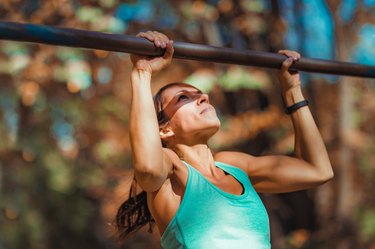
The pull-up is often used as a measure of fitness, and its difficulty makes it a solid benchmark.
The pull-up is a challenging compound exercise that forces you to lift your own body weight. You perform pull-ups on an overhead bar, and how you reach up and grab the bar determines what muscles you use and how difficult the exercise is going to be. Select the version you prefer based on which muscles you're trying to work and your own strength level.
Video of the Day
Video of the Day
Wide- and Close-Grip Pull-Ups
When performing the close-grip pull-up, reach up and grasp the bar with your hands shoulder-width apart and your palms facing forward. During the more traditional, wide-grip pull-up, your palms also face forward, but in this version you grip the overhead bar so that your hands are a few inches outside the width of your shoulders.
The difference in hand placement between the close- and wide-grip pull-ups influences how your shoulder joints move as you perform the exercise.
During the close-grip pull-up, your shoulder joints extend so that your upper arms move directly behind you. When using the wide grip, your shoulders perform a greater degree of adduction, which means your upper arms move in toward the sides of your torso. Both shoulder extension and adduction primarily use the latissimus dorsi, the largest muscle in the back. The latissimus dorsi is the primary mover in both types of pull-ups.
However, during the close-grip version your biceps brachii and pectoralis major are able to contribute, according to ExRx.net. With your hands set closer, you bend your elbows to a greater degree, which recruits the biceps. The pectoralis major helps out with shoulder extension.
Degrees of Difficulty
With your hands in a close-grip position, you place the shoulders and elbows in a more mechanically advantageous position. Placing the hands in a position where the biceps brachii and pectoralis major are able to contribute means that you'll be able to complete more repetitions of close-grip pull-ups than wide grip.
Your latissimus dorsi and other wide-grip pull-up muscles in the back have to lift a greater percentage of your body weight with wide-grip pull-ups, which makes it the more challenging of the two versions.
A Third Option
Another pull-up option is to use a close grip, but with your hands flipped around so that your palms are facing you. While the latissimus dorsi continues to be the primary mover, this version, which is often referred to as a chin-up, more heavily involves the biceps brachii muscle. Therefore, chin-ups are an effective way to build strength for those interested in eventually being able to perform a wide-grip pull-up.
Work Up to It
Can't do a pull-up with either grip? No problem. Try the machine-assisted version. Set the weight rack pin for the amount of assistance desired. For example, if you weigh 150 pounds and want to lift 50 percent of your body weight, set the weight stack at 75 pounds.
Kneel on the padded platform and grab the handles with your desired grip. Lower yourself down until your elbows fully extend; then pull yourself back up.
Was this article helpful?
150 Characters Max
0/150
Thank you for sharing!
Thank you for your feedback!